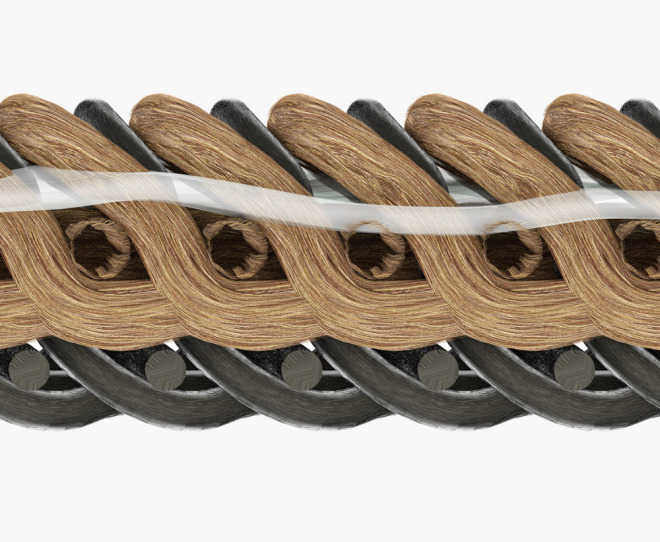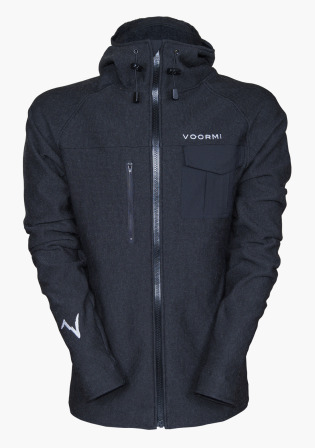
A Colorado company has come up with a way to incorporate a waterproof membrane into a single-layer textile. Voormi’s so-called Core Technology can be used to make thinner and less bulky waterproof outerwear.  Voormi
Voormi
There’s a new way to brace yourself against the cold and wet the next time you hit the ski slopes. It’s a material that’s less bulky, more supple, and more comfortable than whatever is in that jacket you’ve been wearing the last few winters.
A small Colorado-based company, Voormi, is touting a technology that produces a waterproof, breathable textile with only a single layer of material. It could be the most significant advancement in outdoor clothing since the first Gore-Tex jacket with a waterproof-breathable membrane debuted in the mid-1970s.
Voormi’s new approach, announced late last month at the Snowsports Industry Association tradeshow, could eventually replace those stiff, bulky weatherproof shells and conventional layering systems in favor of garments that have multiple, customizable properties—wicking and waterproofing, or insulation and windproofing—all while remaining thin and light. At stake is nothing less than a shakeup of what is a $1.5 billion-per-year market in outerwear in the US alone.
“Our angle is to streamline waterproof breathables into a single-layer construction,” says Timm Smith, Voormi’s marketing director. “So it’s 1978 all over again and we just hit the re-start button.”
Let’s back up: William and Bob Gore invented Gore-Tex in 1969 from polytetrafluoroethylene (PTFE, the base material for Teflon). When rapidly stretched into a thin film, PTFE can become a thin membrane with pores that are smaller than liquid water molecules but larger than water vapor molecules. So it’s impermeable to liquid water like rain or snow, but the moisture you produce as you sweat passes through. Gore-Tex isn’t the only such membrane out there; when the main patent expired in 1997 a number of clothing companies brought out alternative versions.
Membranes—which can be waterproof or just windproof—are the heart of a lot of outdoor clothing, and Voormi’s new technology still uses them. What’s different is how the membrane is applied.
Unlike traditional waterproof-breathable fabrics, which need two layers, Voormi’s new technology is a single-layer textile with a membrane core. It’s lighter, more flexible, and more versatile.
On their own, membranes are pretty fragile. So textile companies laminate the membrane to an outer shell fabric to create a two-layer (2L) textile that can then be cut and stitched into jackets or pants or sleeping bag shells. Most of the time, a third layer—a liner—is added to further improve durability. Fun fact: often that liner layer is polyester tricot, the same material you find in bras.
All of that makes a reasonably functional piece of clothing. But it’s also heavy and bulky due to the layers of fabric, the laminate adhesive, and yards of seam tape needed to cover stitch holes. And all the layers can blunt the membrane’s breathability, making it less effective.
Voormi’s new technique gets rid of the lamination altogether. “Rather than glue a membrane to a fabric, we put the membrane into a knitting machine, knitting a yarn in and around and through the membrane, so we get a single-layer textile with a (membrane) core that’s constructed in the process,” says Smith. “It’s an entirely new platform.”

A cross-section of the single-layer Core Technology textile showing the placement of the waterproof membrane.  Voormi
Voormi
But wait: won’t punching millions of thread holes make the membrane into a sieve? That’s the alchemic moment. In a step Voormi won’t disclose, Smith says the company found a way to reconstitute the integrity of the membrane after the knitting process.
Smith also claims that Voormi can “tune” the membrane’s properties—the balance of waterproofness versus breathability, which is a function of the size of the pores in a membrane. If they’re designing a fabric for a cold but dry environment, like Voormi’s Colorado home, “maybe we cure the membrane back to 70 percent of its waterproofness,” he says. “The ability to custom-balance that level is part of the engineering.”
For anyone used to conventional laminates and ages-old layering approaches, it’s jaw-dropping.
The emphasis in waterproof-breathables has always been on waterproof. That’s why many jackets still have zippered vents. In fact, the standards (led by Gore) on what is truly waterproof are so high that Voormi makes no claim that its garments are 100 percent waterproof. But the company does say that, short of a full-on deluge, they’ll keep you dry, and that they’re more breathable and comfortable than traditional waterproof shells.
Smith says Voormi’s technology works with any kind of membrane, not just waterproof-breathables, and almost any kind of yarn or mix of yarns. Voormi’s own pieces are a wool blend.
“So you could have a single-layer baselayer that’s windproof but still wicks,” explains Smith. “It’s a whole new class of product where we can make a mid-layer that’s a single protective layer—a shirt I can run in and which blocks wind, but won’t get wet from sweat.”

Voormi’s Drift Hydro jacket is the first of the company’s products to feature the new material.  Voormi
Voormi
It all sounds fascinating, but there are a lot of questions about whether they can make this work. Voormi is a tiny brand, located in the equally tiny town of Pagosa Springs, Colorado, and isn’t well known outside of the hardcore skiing and climbing communities.
The Drift Hydro is one of just three pieces Voormi makes that uses Core Construction, although more are on the way, and it costs $400. Voormi makes all of its clothing in the U.S. from exclusively U.S.-sourced materials, down to the sheep that produce the wool. That’s admirable, but even with flexible domestic manufacturing, you likely won’t find thousands of these on store shelves.
But Voormi isn’t aiming to necessarily become a giant clothing brand. Smith said the goal all along has been to license Core Construction to other companies, much like how W.L. Gore licensed Gore-Tex. From the beginning, Voormi has really been two companies: the clothing maker side and a research and development arm called SWNR (Starting With New Rules).
Both aspects are necessary, because it’s a different world than 1969, Smith points out. Licensing alone wouldn’t work like it did for Gore. “Any big (clothing) company out there has zero incentive to make this because they can sell a baselayer and a mid-layer and a portfolio of things,” he says. Voormi’s retail products are intended to be “a catalyst,” says Smith. SWNR produces the innovations while Voormi proves the concept works technically and commercially.
The company hasn’t signed any major licensing agreements yet. Several are in the works, but Voormi wasn’t prepared to announce partners at the SIA show. So for the time being, Voormi’s own pieces are the only place to find Core Construction. That’s fine with them, for now, because they have bigger plans.
While it has only a handful of employees, the staff is an enviable roster of textile engineers, chemists and other innovators. Founder Dan English was General Manager of Business Solutions at Microsoft; Executive VP of Development Doug Lumb spent 43 years at Polartec, where he helped invent synthetic fleece, among other innovations. English’s son, Dustin, has been testing the gear for years in the harsh Alaskan wilderness as a mountain guide. Even Smith, nominally Voormi’s marketing director, was a chemical engineer for W.L. Gore for 12 years prior to joining Voormi.
“There’s this very cool thing here that is only the very small tip of what’s actually going on (at Voormi),” says Smith. “The things you’ll start to see over the next few years, what you see today as Voormi will make sense in a much bigger context than people see right now.”